Is Australia Getting Too Expensive to Live in?
Australia has been ranked one of the most expensive countries to live in, more expensive than other developed countries such as U.S, U.K, Germany and Singapore. A recent article in The Age about the spiralling cost of living in Australia, reports that in terms of developed countries, Australia and Japan are the two most costly, and United States the cheapest.

In general, Australians are paying more for everything from property rental, cars and education to burgers, beer and iPhones. A Big Mac in Australia costs 12% more than in the US, an iPhone is 26% more and a pair of Levi’s is more than double the price.
Do People Feel the Pinch?
The March quarter figures released by the Reserve Banks of Australia (RBA) reveal that inflation is under control. At 2.5%, it is still within the RBA’s comfort range of two to three percent.
On the ground however, people are feeling the pressure. If you’re a parent of two, a weekly trip to the grocery store can set you back $150, petrol $80, child care $500 and utilities $100. This amounts to a sizeable $630 a week for basic spending. Add in your mortgage, expenses for another car, mobile phone, insurance premiums or other incidentals and you won’t have much left of your weekly earnings which ABS estimates at $1454 for full-time employees.
On the big picture, inflation is still relatively low but the price rises are occurring in many fundamental areas such as education (5%), pharmaceuticals (7%), fuel (1.2%) and childcare (3%). Nevertheless, some other areas are seeing deflationary pressure such as food (-0.8%), clothing and footwear (-4%) and furniture (-6.8%). So while industries like manufacturing and finance wind down, sectors like furniture and household retail are seeing more activity.
Consumer Sentiment
If you talk to the person on the street, there seems to be a sentiment of caution. News of job losses in the manufacturing, mining, finance and public sector has been going around and if you haven’t been affected by such affairs you probably know someone who has.
In effect, consumers seem to be more cautious with their paychecks. Based on the latest ING Financial Wellbeing Index, Australians are saving more than ever with the average household having 50% more in savings than two years ago. According to the index, Gen X (35-49) are saving the least amount with a median of $8060 but this is probably due to the high cost of raising children. Savings among the other groups remains strong with $14,400 for Gen Y (18-34) and $17,700 for baby boomers (50-64).
Australia Still Offers Quality Lifestyle
Despite the expensive cost of living suggested by the Deutche Bank survey, Australia remains a popular destination for skilled migrants and professionals. From July 2011 to June 2012, the top four source countries for Australian migrants were New Zealand (20%), China (12%), United Kingdom (9%) and India (8%), and a significant number coming from various Southeast Asian countries (17%).
More so than ever, Australia is seen as a country that embraces a policy of multi-culturalism, recognising the advantages of a culturally diverse and socially-cohesive nation, a policy which has become all the more important with today’s global travel and movement.
Studies show that the cost of living in Australia is significantly more than in source countries. For example, based on Numbeo.com figures, consumer prices in Australia are 32% higher than in the UK and 137% higher than in Malaysia. Rent prices are 44% more than in the UK and 360% more than in Malaysia.
But at the end of the day purchasing power in Australia is higher, 16% higher than in the UK and 48% higher than in Malaysia. Undoubtedly the cost of living has gone up, and it might be harder to maintain a single income household if you have a family but on the flipside other factors are in favour of the average wage earner.
Australians enjoy low mortgage rates, affordable cars and household goods, plus the occasional overseas holiday or two. Based on ABS figures, the average Australian family earns about $65,000 per year (before tax). How much does a family (with kids) need to live comfortably? This is a highly personal decision depending on your lifestyle choices – how many holidays, private school or public, how much do you like your designer goods. Based on some of the blogs out there $100,000 is pretty good but I know a lot of families who are happy with less.
